Dependences of Rheological and Compression Mechanical Properties on Cellular Structures for Impact-Protective Materials
- PMID: 31457572
- PMCID: PMC6641077
- DOI: 10.1021/acsomega.7b00242
Dependences of Rheological and Compression Mechanical Properties on Cellular Structures for Impact-Protective Materials
Abstract
In this study, three typical impact-protective materials, D3O, PORON XRD, and DEFLEXION were chosen to explore the dependences of rheological and compression mechanical properties on the internal cellular structures with polymer matrix characteristics, which were examined using Fourier transform infrared spectroscopy, thermogravimetric analyses, and scanning electron microscopy with energy dispersive spectroscopy. The rheological property of these three foaming materials were examined using a rheometer, and the mechanical property in a compression mode was further examined using an Instron universal tensile testing machine. The dependences of rheological parameters, such as dynamic moduli, normalized moduli, and loss tangent, on angular frequency, and the dependences of mechanical properties in compression, such as the degree of strain-hardening, hysteresis, and elastic recovery, on the strain rate for D3O, PORON XRD, and DEFLEXION can be well-correlated with their internal cellular structural parameters, revealing, for example, that D3O and PORON XRD exhibit simultaneously high strength and great energy loss in a high-frequency impact, making them suitable for use as soft, close-fitting materials; however, DEFLEXION dissipates much energy whether it suffers a large strain rate or not, making it suitable for use as a high-risk impact-protective material. The rheometry and compression tests used in this study can provide the basic references for selecting and characterizing certain impact-protective materials for applications.
Conflict of interest statement
The authors declare no competing financial interest.
Figures


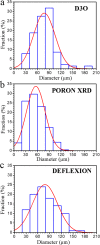
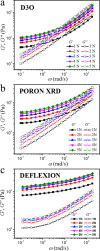

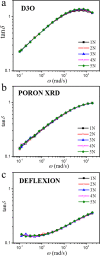
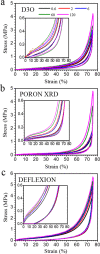
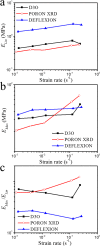
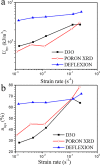

Similar articles
-
Mechanical properties of 3 hydrophilic addition silicone and polyether elastomeric impression materials.J Prosthet Dent. 2004 Aug;92(2):151-4. doi: 10.1016/j.prosdent.2004.05.016. J Prosthet Dent. 2004. PMID: 15295324
-
[Comparative analysis of elastic materials for lining of removable dental prosthesis in vitro].Ann Acad Med Stetin. 2002;48:163-78. Ann Acad Med Stetin. 2002. PMID: 14601476 Polish.
-
Recent advances in the use of graphene-family nanoadsorbents for removal of toxic pollutants from wastewater.Adv Colloid Interface Sci. 2014 Feb;204:35-56. doi: 10.1016/j.cis.2013.12.005. Epub 2013 Dec 26. Adv Colloid Interface Sci. 2014. PMID: 24412086
-
Nanosilica-induced high mechanical strength of nanocomposite hydrogel for killing fluids.J Colloid Interface Sci. 2015 Nov 15;458:45-52. doi: 10.1016/j.jcis.2015.07.006. Epub 2015 Jul 6. J Colloid Interface Sci. 2015. PMID: 26203591
-
Mechanical properties of contact lenses: The contribution of measurement techniques and clinical feedback to 50 years of materials development.Cont Lens Anterior Eye. 2017 Apr;40(2):70-81. doi: 10.1016/j.clae.2016.11.005. Epub 2016 Nov 22. Cont Lens Anterior Eye. 2017. PMID: 27884616 Review.
Cited by
-
Detection of adulteration in Iranian grape molasses added glucose/fructose/sugar beet syrups with 13C/12C isotope ratio analysis method.Food Sci Nutr. 2024 Sep 10;12(10):8432-8440. doi: 10.1002/fsn3.4259. eCollection 2024 Oct. Food Sci Nutr. 2024. PMID: 39479716 Free PMC article.
-
Effect of Accelerated Ageing on the Mechanical and Structural Properties of the Material System Used in Protectors.Polymers (Basel). 2019 Jul 30;11(8):1263. doi: 10.3390/polym11081263. Polymers (Basel). 2019. PMID: 31366100 Free PMC article.
-
Selectively damping materials for next-generation motion-artifact-free skin-interfaced soft bioelectronics.Mater Horiz. 2025 Jul 2. doi: 10.1039/d5mh00700c. Online ahead of print. Mater Horiz. 2025. PMID: 40600453 Free PMC article. Review.
References
-
- Avalle M.; Belingardi G.; Montanini R. Characterization of Polymeric Structural Foams under Compressive Impact Loading by Means of Energy-Absorption Diagram. Int. J. Impact Eng. 2001, 25, 455–472. 10.1016/s0734-743x(00)00060-9. - DOI
-
- David N. V.; Gao X.-L.; Zheng J. Q. Ballistic Resistant Body Armor: Contemporary and Prospective Materials and Related Protection Mechanisms. Appl. Mech. Rev. 2009, 62, 050802.10.1115/1.3124644. - DOI
-
- Ferguson J. R.Impact Shock Absorbing Material. U.S. Patent 8,087,101, Jan 3, 2012.
-
- Brzeziński S.; Malinowska G.; Nowak T. High-tech Sports Clothing with a High Comfort of Use Made from Multi-layer Composite Materials. Fibres Text. East. Eur. 2005, 13, 90–93.
LinkOut - more resources
Full Text Sources
Other Literature Sources

